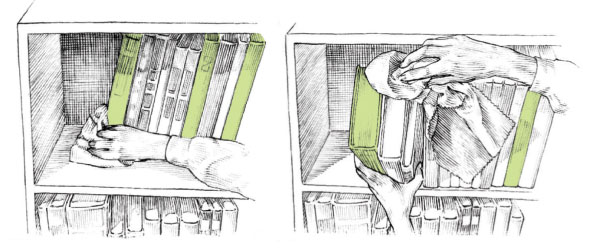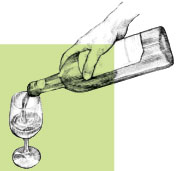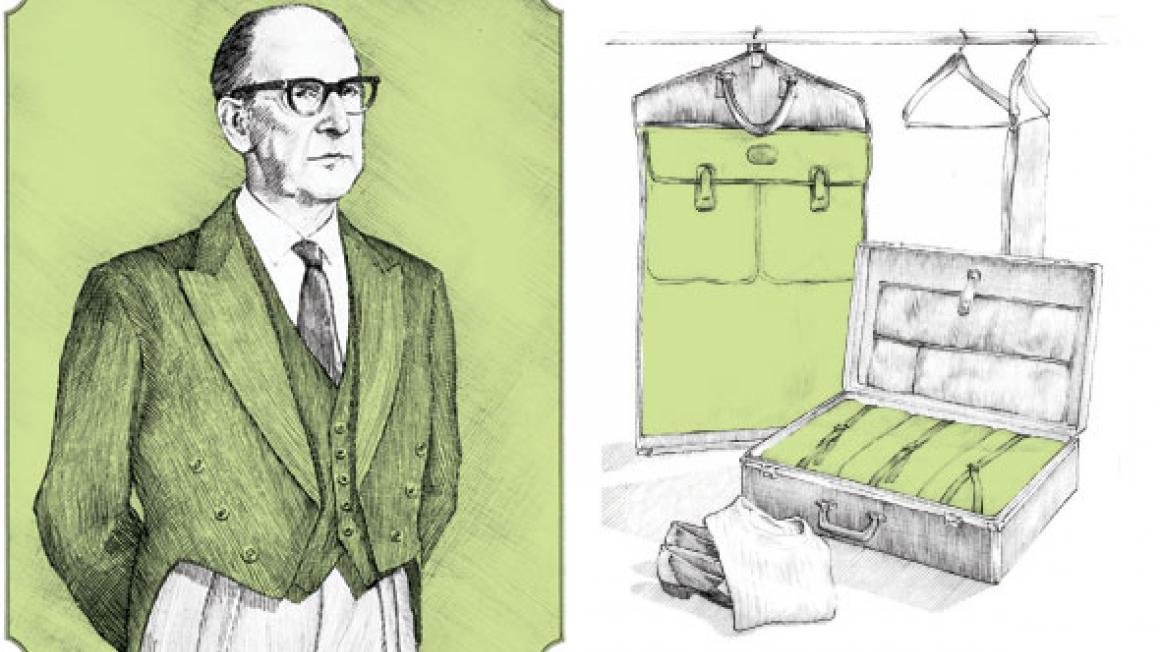HOW TO TELL A WHITE LIE…

HOW TO PACK
When you take clothes out of your wardrobe, they should be ready for wear and ready for packing. If you brushed them before you put them away and kept them in a good tight wardrobe, they shouldn’t want brushing before being put into the case. But do brush them when you unpack them. This helps get rid of any light creases and freshens them up.Tissue paper: It is impossible to pack properly without an ample supply of tissue paper. Used correctly, tissue paper protects garments and helps prevent wrinkling.
There are two kinds of tissue paper: acid and nonacid. Acid tissue paper is ordinary tissue, sometimes used for wrapping a loaf of bread. It is soft, tears easily and looks slightly yellow. Nonacid tissue is pure white. I use the toughest, whitest, thickest nonacid tissue paper I can find, which is the most practical for packing clothes. Women’s clothes should be packed with more tissue paper than men’s because they are generally made of softer material. A garment of particularly fine material, such as a silk dress, should be laid flat on tissue paper before folding.
Loading a case: Pack heavy clothes at the bottom of a case and lighter garments towards the top so that less weight bears on them.
Trousers: Put trousers at the bottom of the case, because they need to be flat. To protect the crease on the front trouser leg, let it face towards the handle of the case where less weight will bear on it.

Skirts: A lightweight skirt should lie near the top of the case, and a wool or tweed skirt is best placed flat at the bottom near the trousers.
Jackets: Pack jackets after trousers or heavy skirts. Depending on the size of the case and the length of the jacket, it can perhaps lie between the back of the case and the handle with the collar facing towards the handle. If it is too large, lay it across the case, with the collar facing towards the centre of the case and not pressed against the side
Shirts: As shirts are light garments, put them near the top of your packing. If you do not have a shirt bag, lay them on clean underwear. Shirt collars crease more easily than reinforced jacket collars and must face towards the centre of the case. Shirt fronts must be kept away from grease or anything else that might stain them, so do not pack them near shoes, unless the shoes are covered.
Dresses: Pack a soft dress near the top of your case and a heavy woollen dress near the bottom. For neatlooking packing, turn a dress over before you lay it in the case so that the front faces upwards.
Jumpers: Most ordinary jumpers can fit in with the contours of everything else and can be used to fill gaps in your suitcase. Jumpers could also be wrapped round the soles of shoes to keep them from touching shirts or underwear. Pack fine jumpers more carefully, near the top of your case.
Linen, socks and gloves: These small items help keep packing in a firm block if they are laid flat and used to fill gaps.
Ties: Lay ties flat, either in a parcel of tissue paper or in a plastic shirt bag. Or lay them between your underwear or between your underwear and shirts. Always place them near the top of your case to prevent them from crushing.
Shoes: Depending on the gaps in the case, I can often fit a pair of lowheeled shoes in one of the back corners against a folded jacket shoulder. The soles of the shoes are facing, but not lying on, the trousers or skirt, and this helps keep them in position. Pack a pair of high-heeled shoes in a corner, so that the heels rest against the side of the case and the uppers face towards the centre of your packing. Wrap a pair of socks round the heels so they can’t damage the other garments. When I was a footman, we always wrapped shoes in tissue paper for travelling as shoe soles were kept highly polished. I prefer to use a shoe bag or to cover shoes with a jumper; plastic bags tear easily, brown wrapping paper is too stiff, and the ink from a newspaper will mark your clothes.
Dressing gown: Pack a dressing gown as a protective covering over the rest of the items in the case. To do this, lay it flat in the case after everything but your raincoat has been packed. Fold it down around the contents of the case.
Raincoat: Although a raincoat is the last item to pack, the material is too stiff to be used to keep the packing tight. After you have folded the raincoat, tuck any extra material into the folds to keep the case tidy.
HOW TO TELL A WHITE LIE
We had to be discreet and reticent and protect our employers from unnecessary intrusions. On occasion this called for a white lie. The most common one was required when a member of the family gave instructions that he or she didn’t wish to be disturbed and then someone came to call. In this case we would simply say the person was not at home.
This often happened when someone came to call on Lady Dunsany in London. She would leave a card lying on the hall table that said ‘Not At Home’. This warned us to tell any visitor that she was out, even if we knew she was in.
Sometimes a caller would insist, ‘But I saw her go in’. This made no difference. ‘You may have seen her go in, but she’s not at home,’ I’d say politely but firmly. Then the visitor knew she was unavailable and would leave a card for me to give Her Ladyship. And she returned the compliment of their call by sending back her card. One of the footmen would have the chauffeur for the afternoon and be driven round London delivering all Her Ladyship’s calling cards.
HOW TO STAND STILL
This is one of the things that all footmen learnt, as we often had to do it when on duty. I am glad I have this knowledge; I have found it useful on all sorts of occasions, even when I haven’t been working.The secret is simple; you must be relaxed. You should stand with your feet eight inches apart, hold your normal posture and keep your head firmly upright – not poked forward or leant back.
We stood with our hands behind us, so that if we needed to flex our fingers we could do so without anyone seeing us. I once worked under a butler called Pack, who loved to play practical jokes. He came behind me when I was standing on duty one night and popped a hot potato into my hands. I didn’t know what the devil to do with it, so I put it in my tailcoat pocket. But then of course it started burning the back of my thigh, which was even more sensitive than my hands! I think Pack was the most eccentric butler that I ever worked under.

HOW TO DUST BOOKS
Dust is abrasive and should not be permitted to accumulate on fine bindings. Give your books and bookshelves a thorough dusting once a month. Take out the first four books at the end of a shelf and dust the space they have vacated with a duster or the nozzle of your vacuum cleaner. You now have enough room to move the rest of the books backwards and forwards. Push them back against the wall or to the back of the bookcase and dust the shelf in front of them. Then pull them out to the edge again, which is now dust free. Tip three or four books towards you, and supporting them with your left hand, dust the tops of the pages and the spines with your right hand. Do this with groups of books until you reach the end of the shelf. Take out the last book and dust the exposed cover, then return it to its place. Lastly, dust the four books you removed, including the outside cover of the fi rst book on the shelf, and replace them.HOW TO PUSH IN A CHAIR… SAFELY
Despite your good intentions you can put someone on the floor if you don’t know how to do this properly.Whatever you do, you must not tilt the chair. As the person is bending his or her knees to sit down, take hold of the back of the chair with both hands and place your foot underneath the chair. Then ease it forward by bending your knee, and at the same time gently push the back of the chair with your hands.
HOW TO CLOSE A DOOR QUIETLY
On party nights two matched footmen stood ready to open the doors leading to the reception rooms. They were both six feet tall, wore identical liveries and had similar features. So that the guests would have no trouble acknowledging them, whoever stood on the left was called John and the other was addressed as James, regardless of their real names.You never heard a footman actually close a door, it was done so quietly and discreetly. I open and close a door the same way today. The trick is to release the door handle only once.
Most people open a door, let go of the handle, walk through the doorway, take hold of the handle again and shut the door. But after I have opened a door, I keep the handle turned until I have passed through the doorway. Then, without releasing the catch, I take hold of the handle in my other hand. I hold it in the same position until I have gently closed the door and the catch is ready to click into place.
HOW TO POUR WINE 
I grasp a single bottle firmly in my right hand so that my wrist is above the bottle. My forefinger presses against the shoulder; my thumb is about an inch below the shoulder at a slight angle, opposite my second finger, which is pressed against the body of the bottle on the other side. I feel holding a bottle this way gives me more control than grasping it round the neck.The Butler’s Guide To Running The Home And Other Graces by Stanley Ager and Fiona St Aubyn is published by The Robson Press, priced £14.99


